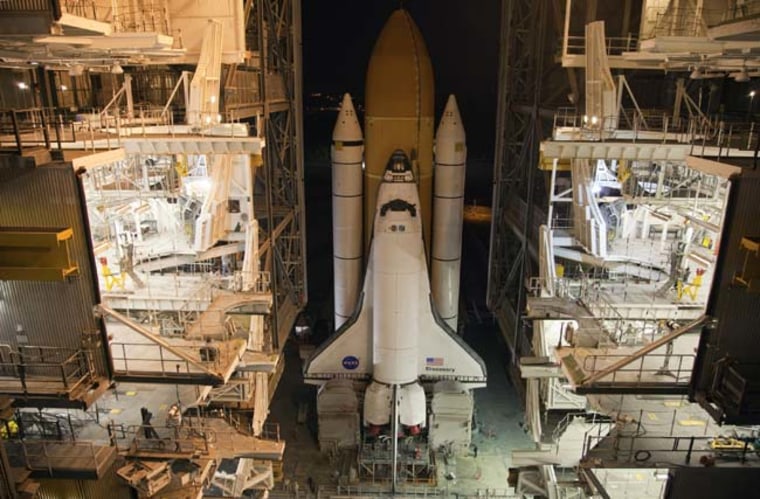NASA has completed its latest round of X-ray scans on the space shuttle Discovery's external fuel tank, only to find more small cracks on the beleaguered tank's support beams, the space agency announced Thursday.
The four new cracks were discovered on the tops of three metal ribs on the back side of the tank's midsection, opposite from the Discovery orbiter. Shuttle program managers met on Thursday and elected to repair these fresh fractures in the same way that earlier cracks found on the tank were fixed. This work will likely begin Jan. 3, and is estimated to take two to three days.
"Any further work will be evaluated thoroughly early next week after additional data is reviewed," NASA officials said in a statement.
Discovery is currently slated to launch no earlier than Feb. 3 after months of delay. The shuttle's upcoming mission to the International Space Station will be the final flight of the workhorse orbiter before it is retired.
Attempts to launch Discovery on its final voyage in early November were delayed by weather, a gas leak and — ultimately — due to small cracks found in some of the 108 aluminum ribs in the so-called intertank part of Discovery's 15-story external tank.
The intertank portion of the tank, as its name suggests, is between the vessel's liquid hydrogen and liquid oxygen propellant reservoirs. It also houses much of the tank's wiring and instrumentation.
Discovery rolled back to the Vehicle Assembly Building at NASA's Kennedy Space Center in Florida last week so technicians could take a closer look at the orbiter's external tank. They took digital X-ray images of each of the 108 supports — known in NASA parlance as "stringers" — on the exterior of the intertank section.
Other small cracks had been found on two of these ribs – after Discovery's launch countdown on Nov. 5 — prompting a string of delays for closer analysis to determine the root cause.
While those previous cracks have since been repaired, shuttle program managers opted to postpone Discovery's final launch until February to give engineers more time to understand how the cracks developed, and whether they could pose future concerns. [Gallery: Building Space Shuttle Discovery]
NASA also conducted a so-called "tanking test" on Dec. 17, in which the shuttle's fuel tank was filled as it normally would be up until the final seconds before liftoff. Sensors that were installed on the tank recorded data as hundreds of thousands of gallons of cryogenic propellant was pumped into, and then drained from, the external tank.
The sensors also monitored the tank's performance into the next day as it warmed to ambient temperature.
On its 39th and final flight, the shuttle Discovery will carry supplies to the International Space Station, including a storage room and humanoid robot helper, called Robonaut 2. Two spacewalks are also planned for the 11-day mission.
Discovery's STS-133 flight is one two final scheduled missions before NASA's orbiter fleet is retired in 2011. The agency is retiring the space shuttle program in order to shift its focus toward future missions to an asteroid and Mars. NASA is hoping to launch one additional shuttle flight around June, but it is still awaiting approval for funding from a congressional appropriations committee.
- 11 Things Americans Will Be Doing in Space in 2011
- Video – Space Shuttle Discovery: A Retrospective
- Space Shuttle Discovery's Retirement Plan in Limbo
You can follow Space.com Staff Writer Denise Chow on Twitter .
